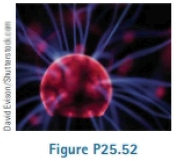
Physics for Scientists and Engineers (AP Edition)
9th Edition
ISBN: 9781133953951
Author: Raymond A. Serway, John W. Jewett
Publisher: Cengage Learning
expand_more
expand_more
format_list_bulleted
Concept explainers
Textbook Question
Chapter 25, Problem 25.52P
Lightning can be studied with a Van de Graaff generator, which consists of a spherical dome on which charge is continuously deposited by a moving belt. Charge can be added until the electric field at the surface of the dome becomes equal to the dielectric strength of air. Any more charge leaks off in sparks as shown in Figure P25.52. Assume the dome has a diameter of 30.0 cm and is surrounded by dry air with a "breakdown" electric field of 3.00 × 106 V/m. (a) What is the maximum potential of the dome? (b) What is the maximum charge on the dome?

Expert Solution & Answer
Trending nowThis is a popular solution!

Students have asked these similar questions
pls help asap
pls help asap
2. Max is swimming across a river that is 42.6 m wide. He can swim at 1.6 m/s and heads 20° to the right of the
vertical. There is a current pushing him more to the right and it has a speed of 0.30 m/s. Determine the time it
takes him to cross the river and find out how far downstream he ends up. Draw the diagram.
Chapter 25 Solutions
Physics for Scientists and Engineers (AP Edition)
Ch. 25 - In Figure 24.1, two points and are located...Ch. 25 - The labeled points in Figure 24.4 are on a series...Ch. 25 - In Figure 24.8b, take q2, to be a negative source...Ch. 25 - In a certain region of space, the electric...Ch. 25 - In a certain region of space, the electric field...Ch. 25 - Consider the equipotential surfaces shown in...Ch. 25 - (i) A metallic sphere A of radius 1.00 cm is...Ch. 25 - The electric potential at x = 3.00 m is 120 V, and...Ch. 25 - Rank the potential energies of the lour systems of...Ch. 25 - In a certain region of space, a uniform electric...
Ch. 25 - Rank the electric potentials at the four points...Ch. 25 - An electron in an x-ray machine is accelerated...Ch. 25 - Rank the electric potential energies of the...Ch. 25 - Four particles are positioned on the rim of a...Ch. 25 - A proton is released from rest at the origin in a...Ch. 25 - A particle with charge -40.0 nC is on the x axis...Ch. 25 - A filament running along the x axis from the...Ch. 25 - In different experimental trials, an electron, a...Ch. 25 - A helium nucleus (charge = 2e. mass = 6.63 ...Ch. 25 - What determines the maximum electric potential to...Ch. 25 - Describe the motion of a proton (a) after it is...Ch. 25 - When charged particles are separated by an...Ch. 25 - Study Figure 23.3 and the accompanying text...Ch. 25 - Distinguish between electric potential and...Ch. 25 - Describe the equipotential surfaces for (a) an...Ch. 25 - Oppositely charged parallel plates are separated...Ch. 25 - A uniform electric field of magnitude 250 V/m is...Ch. 25 - (a) Calculate the speed of a proton that is...Ch. 25 - How much work is done (by a battery, generator, or...Ch. 25 - A uniform electric field of magnitude 325 V/m is...Ch. 25 - Starting with the definition of work, prove that...Ch. 25 - An electron moving parallel to the x axis has an...Ch. 25 - (a) Find the electric potential difference Ve...Ch. 25 - A particle having charge q = +2.00 C and mass m =...Ch. 25 - Review. A block having mass m and charge + Q is...Ch. 25 - An insulating rod having linear charge density =...Ch. 25 - (a) Calculate the electric potential 0.250 cm from...Ch. 25 - Two point charges are on the y axis. A 4.50-C...Ch. 25 - The two charges in Figure P25.14 are separated by...Ch. 25 - Three positive charges are located at the corners...Ch. 25 - Two point charges Q1 = +5.00 nC and Q2 = 3.00 nC...Ch. 25 - Two particles, with charges of 20.0 11C and -20.0...Ch. 25 - The two charges in Figure P24.12 are separated by...Ch. 25 - Given two particles with 2.00-C charges as shown...Ch. 25 - At a certain distance from a charged particle, the...Ch. 25 - Four point charges each having charge Q are...Ch. 25 - The three charged particles in Figure P25.22 are...Ch. 25 - A particle with charge +q is at the origin. A...Ch. 25 - Show that the amount of work required to assemble...Ch. 25 - Two particles each with charge +2.00 C are located...Ch. 25 - Two charged particles of equal magnitude are...Ch. 25 - Four identical charged particles (q = +10.0 C) are...Ch. 25 - Three particles with equal positive charges q are...Ch. 25 - Five particles with equal negative charges q are...Ch. 25 - Review. A light, unstressed spring has length d....Ch. 25 - Review. Two insulating spheres have radii 0.300 cm...Ch. 25 - Review. Two insulating spheres have radii r1 and...Ch. 25 - How much work is required to assemble eight...Ch. 25 - Four identical particles, each having charge q and...Ch. 25 - In 1911, Ernest Rutherford and his assistants...Ch. 25 - Figure P24.22 represents a graph of the electric...Ch. 25 - The potential in a region between x = 0 and x =...Ch. 25 - An electric field in a region of space is parallel...Ch. 25 - Over a certain region of space, the electric...Ch. 25 - Figure P24.23 shows several equipotential lines,...Ch. 25 - The electric potential inside a charged spherical...Ch. 25 - It is shown in Example 24.7 that the potential at...Ch. 25 - Consider a ring of radius R with the total charge...Ch. 25 - A uniformly charged insulating rod of length 14.0...Ch. 25 - A rod of length L (Fig. P24.25) lies along the x...Ch. 25 - For the arrangement described in Problem 25,...Ch. 25 - A wire having a uniform linear charge density is...Ch. 25 - The electric field magnitude on the surface of an...Ch. 25 - How many electrons should be removed from an...Ch. 25 - A spherical conductor has a radius of 14.0 cm and...Ch. 25 - Electric charge can accumulate on an airplane in...Ch. 25 - Lightning can be studied with a Van de Graaff...Ch. 25 - Why is the following situation impossible? In the...Ch. 25 - Review. In fair weather, the electric field in the...Ch. 25 - Review. From a large distance away, a particle of...Ch. 25 - Review. From a large distance away, a particle of...Ch. 25 - The liquid-drop model of the atomic nucleus...Ch. 25 - On a dry winter day, you scuff your leather-soled...Ch. 25 - The electric potential immediately outside a...Ch. 25 - (a) Use the exact result from Example 24.4 to find...Ch. 25 - Calculate the work that must be done on charges...Ch. 25 - Calculate the work that must be done on charges...Ch. 25 - The electric potential everywhere on the xy plane...Ch. 25 - Why is the following situation impossible? You set...Ch. 25 - From Gauss's law, the electric field set up by a...Ch. 25 - A uniformly charged filament lies along the x axis...Ch. 25 - The thin, uniformly charged rod shown in Figure...Ch. 25 - A GeigerMueller tube is a radiation detector that...Ch. 25 - Review. Two parallel plates having charges of...Ch. 25 - When an uncharged conducting sphere of radius a is...Ch. 25 - An electric dipole is located along the y axis as...Ch. 25 - A solid sphere of radius R has a uniform charge...Ch. 25 - A disk of radius R (Fig. P24.49) has a nonuniform...Ch. 25 - Four balls, each with mass m, are connected by...Ch. 25 - (a) A uniformly charged cylindrical shell with no...Ch. 25 - As shown in Figure P25.76, two large, parallel,...Ch. 25 - A particle with charge q is located at x = R, and...
Knowledge Booster
Learn more about
Need a deep-dive on the concept behind this application? Look no further. Learn more about this topic, physics and related others by exploring similar questions and additional content below.Similar questions
- No chatgpt pls will upvotearrow_forwardis 0.3026 a finite numberarrow_forwardPlastic beads can often carry a small charge and therefore can generate electric fields. Three beads are oriented such that system of all three beads is zero. 91 E field lines 93 92 What charge does each bead carry? 91 92 -1.45 = = What is the net charge of the system? What charges have to be equal? μC 2.9 × What is the net charge of the system? What charges have to be equal? μC 93 = 2.9 μС 92 is between and 91 93° The sum of the charge on q₁ and 92 is 91 + 92 = −2.9 μC, and the net charge of thearrow_forward
arrow_back_ios
SEE MORE QUESTIONS
arrow_forward_ios
Recommended textbooks for you
 Physics for Scientists and Engineers: Foundations...PhysicsISBN:9781133939146Author:Katz, Debora M.Publisher:Cengage Learning
Physics for Scientists and Engineers: Foundations...PhysicsISBN:9781133939146Author:Katz, Debora M.Publisher:Cengage Learning Physics for Scientists and Engineers, Technology ...PhysicsISBN:9781305116399Author:Raymond A. Serway, John W. JewettPublisher:Cengage Learning
Physics for Scientists and Engineers, Technology ...PhysicsISBN:9781305116399Author:Raymond A. Serway, John W. JewettPublisher:Cengage Learning College PhysicsPhysicsISBN:9781938168000Author:Paul Peter Urone, Roger HinrichsPublisher:OpenStax College
College PhysicsPhysicsISBN:9781938168000Author:Paul Peter Urone, Roger HinrichsPublisher:OpenStax College
 Physics for Scientists and Engineers with Modern ...PhysicsISBN:9781337553292Author:Raymond A. Serway, John W. JewettPublisher:Cengage Learning
Physics for Scientists and Engineers with Modern ...PhysicsISBN:9781337553292Author:Raymond A. Serway, John W. JewettPublisher:Cengage Learning Physics for Scientists and EngineersPhysicsISBN:9781337553278Author:Raymond A. Serway, John W. JewettPublisher:Cengage Learning
Physics for Scientists and EngineersPhysicsISBN:9781337553278Author:Raymond A. Serway, John W. JewettPublisher:Cengage Learning

Physics for Scientists and Engineers: Foundations...
Physics
ISBN:9781133939146
Author:Katz, Debora M.
Publisher:Cengage Learning

Physics for Scientists and Engineers, Technology ...
Physics
ISBN:9781305116399
Author:Raymond A. Serway, John W. Jewett
Publisher:Cengage Learning

College Physics
Physics
ISBN:9781938168000
Author:Paul Peter Urone, Roger Hinrichs
Publisher:OpenStax College


Physics for Scientists and Engineers with Modern ...
Physics
ISBN:9781337553292
Author:Raymond A. Serway, John W. Jewett
Publisher:Cengage Learning

Physics for Scientists and Engineers
Physics
ISBN:9781337553278
Author:Raymond A. Serway, John W. Jewett
Publisher:Cengage Learning
Electric Fields: Crash Course Physics #26; Author: CrashCourse;https://www.youtube.com/watch?v=mdulzEfQXDE;License: Standard YouTube License, CC-BY